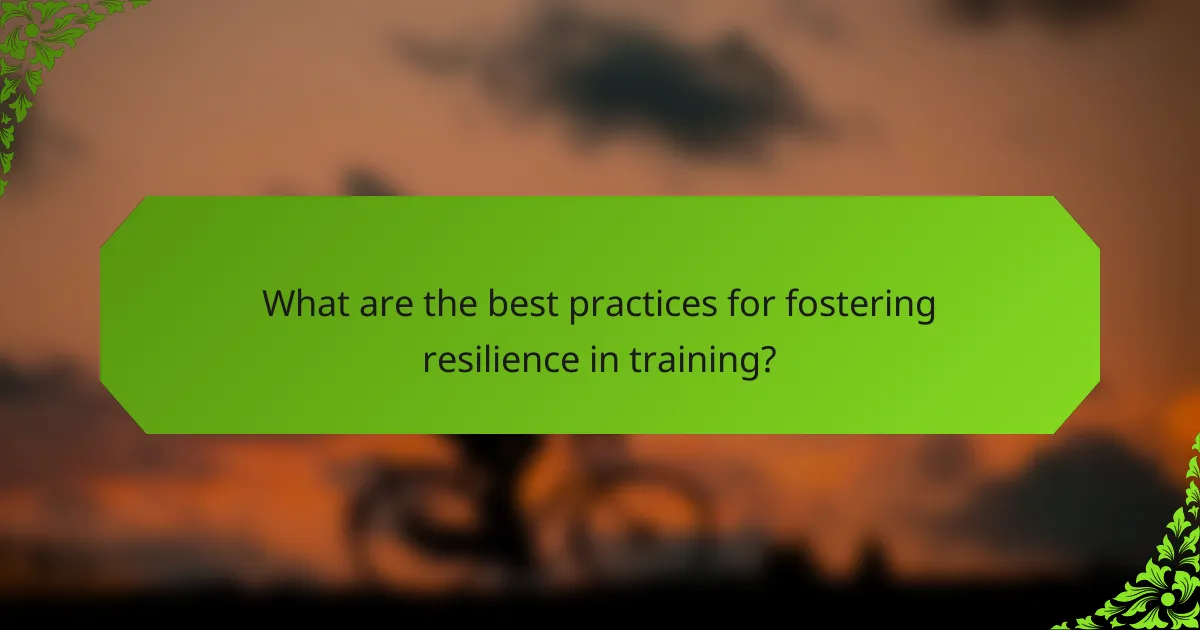Cultivating resilience and grit is essential for amateur athletes to overcome challenges and enhance performance. This article explores effective resilience-building techniques, including mental conditioning, goal setting, and mindfulness practices. It highlights the importance of adaptability, emotional intelligence, and intrinsic motivation. Additionally, it outlines a structured protocol for implementing these strategies in training and competition.

What is the role of resilience in amateur athletics?
Resilience plays a crucial role in amateur athletics by enabling athletes to overcome challenges and maintain motivation. It fosters mental toughness, allowing athletes to bounce back from setbacks and improve performance. Resilient athletes often exhibit grit, which enhances their commitment and perseverance during training and competitions. Studies indicate that athletes with higher resilience levels experience reduced stress and anxiety, leading to improved overall well-being and performance outcomes. Cultivating resilience through structured protocols can significantly benefit amateur athletes, equipping them with essential skills for both sports and life.
How does grit differentiate successful athletes?
Grit significantly differentiates successful athletes by fostering perseverance and resilience. This mental toughness enables athletes to push through challenges and maintain focus on long-term goals. Research indicates that grit correlates with higher achievement levels in sports, as it drives consistent practice and effort. Successful athletes often exhibit unique attributes, such as a strong commitment to their training regimen and the ability to recover from setbacks. Cultivating grit through structured protocols enhances performance and overall life balance for amateur athletes.
What are the key components of resilience for athletes?
Resilience in athletes comprises mental toughness, emotional regulation, adaptability, and social support. Mental toughness allows athletes to stay focused under pressure. Emotional regulation helps manage stress and anxiety. Adaptability enables quick recovery from setbacks. Social support fosters motivation and resilience through connections with coaches and peers.
How can mental toughness be developed?
Mental toughness can be developed through consistent practice and strategic approaches. Key methods include setting clear goals, embracing challenges, and maintaining a positive mindset.
1. Establish specific, measurable goals to enhance focus and motivation.
2. Engage in regular physical training to build resilience and grit.
3. Practice visualization techniques to prepare for challenges and setbacks.
4. Develop a support system of coaches and peers for encouragement and accountability.
5. Reflect on experiences to learn from failures and successes, fostering growth.
These strategies cultivate the mental strength necessary for amateur athletes to thrive in competitive environments.
What strategies enhance emotional regulation?
Practicing mindfulness, setting realistic goals, and developing a support network enhance emotional regulation in amateur athletes. Mindfulness techniques, such as deep breathing and meditation, foster self-awareness and reduce stress. Setting achievable goals builds confidence and motivation. A strong support network provides emotional reinforcement and accountability, promoting resilience and grit.
What unique practices cultivate grit in amateur athletes?
Amateur athletes cultivate grit through unique practices like goal-setting, consistent reflection, and embracing challenges. These strategies enhance resilience, enabling athletes to overcome setbacks.
Goal-setting involves defining clear, measurable objectives, which fosters motivation and focus. Consistent reflection allows athletes to assess their progress and learn from experiences, reinforcing a growth mindset. Embracing challenges helps develop mental toughness, as athletes learn to navigate obstacles and maintain perseverance.
These practices create a robust framework for resilience, equipping amateur athletes with the grit necessary for long-term success.
How can goal-setting improve perseverance?
Goal-setting enhances perseverance by providing clear objectives and measurable milestones. This structured approach fosters resilience in amateur athletes, encouraging them to overcome challenges. Research shows that athletes who set specific goals maintain focus and motivation, leading to improved performance. Additionally, goal-setting creates a sense of accountability, making it easier to navigate setbacks and remain committed to long-term success.
What role does failure play in building grit?
Failure is crucial for building grit as it fosters resilience in amateur athletes. Experiencing setbacks teaches them to confront challenges and develop perseverance. This process enhances their mental toughness, allowing them to push through difficulties. As a result, failure becomes a valuable teacher, shaping their growth and commitment to their sport.

What universal resilience-building techniques are effective for athletes?
Effective universal resilience-building techniques for athletes include mental conditioning, goal setting, and mindfulness practices. These strategies enhance mental toughness and adaptability in challenging situations. Mental conditioning focuses on developing a positive mindset through visualization and affirmations. Goal setting involves creating specific, measurable objectives that foster motivation and progress tracking. Mindfulness practices, such as meditation and breathing exercises, improve focus and reduce anxiety. Implementing these techniques cultivates grit, enabling amateur athletes to overcome obstacles and maintain performance under pressure.
How can visualization techniques enhance performance?
Visualization techniques can significantly enhance performance by improving focus and confidence. These methods enable amateur athletes to mentally rehearse their skills, leading to increased resilience and grit. For instance, visualizing successful outcomes can reduce anxiety and foster a positive mindset. Research indicates that athletes who employ visualization report better performance metrics and improved emotional regulation. By integrating these techniques into training, athletes can cultivate a stronger mental framework, ultimately enhancing their overall performance.
What are the benefits of positive self-talk?
Positive self-talk enhances mental resilience, boosts confidence, and improves performance in amateur athletes. It fosters a growth mindset, enabling athletes to overcome challenges. Research shows that athletes using positive affirmations experience reduced anxiety and increased focus. This practice cultivates grit, allowing athletes to persist through setbacks.

What rare attributes contribute to exceptional resilience?
Exceptional resilience in amateur athletes is often influenced by rare attributes such as adaptability, emotional intelligence, and intrinsic motivation. Adaptability allows athletes to adjust to new challenges and setbacks effectively. Emotional intelligence helps them manage stress and maintain focus during competitions. Intrinsic motivation drives them to pursue their goals despite obstacles. These attributes collectively enhance their ability to overcome adversity and maintain a positive mindset.
How does adaptability influence an athlete’s success?
Adaptability significantly influences an athlete’s success by enhancing resilience and grit. Athletes who can adjust to changing conditions, setbacks, and challenges are more likely to thrive. This adaptability allows them to maintain focus on long-term goals while effectively managing stress and pressure. Research indicates that athletes demonstrating high adaptability often achieve better performance outcomes and improved mental health. Cultivating this trait through specific training protocols can lead to sustained success in amateur sports.
What uncommon methods foster adaptability?
Uncommon methods that foster adaptability include mindfulness practices, unconventional training environments, and peer-led learning. Mindfulness enhances mental resilience, allowing athletes to manage stress effectively. Unconventional environments, such as nature-based training, stimulate creative problem-solving. Peer-led learning promotes shared experiences and adaptability through collaborative strategies.
What is the significance of community support in resilience?
Community support is vital for resilience as it fosters a sense of belonging and shared strength. This support helps amateur athletes navigate challenges, enhancing their mental grit and emotional stability. Studies show that athletes with strong community ties exhibit greater perseverance and improved performance under pressure. Engaging with supportive peers not only boosts motivation but also provides essential resources and encouragement during difficult times.

How can amateur athletes implement a resilience protocol?
Amateur athletes can implement a resilience protocol by incorporating specific mental and physical strategies. Start with goal setting to create clear objectives. Develop a routine that includes regular training, recovery, and nutrition. Engage in mindfulness practices to enhance focus and reduce stress. Build a support network of coaches and peers for motivation and accountability. Track progress to identify areas for improvement and celebrate achievements. These steps cultivate resilience and grit, essential attributes for long-term success.
What daily practices enhance grit and resilience?
Daily practices that enhance grit and resilience include setting specific goals, maintaining a growth mindset, and engaging in regular self-reflection. These practices help amateur athletes develop mental toughness. For example, tracking progress fosters accountability and motivation. Additionally, cultivating a supportive environment encourages perseverance. Research indicates that athletes who practice resilience techniques improve performance and adaptability.
How can athletes track their progress effectively?
Athletes can track their progress effectively by setting specific, measurable goals and utilizing consistent metrics. Regularly recording performance data, such as training intensity and recovery times, fosters resilience and grit. Incorporating feedback from coaches and peers enhances accountability and motivation. Utilizing technology, like fitness apps or wearables, provides real-time insights into performance trends.
What common mistakes do athletes make in building resilience?
Athletes often make several common mistakes when building resilience. These include neglecting mental training, underestimating recovery time, and failing to set realistic goals.
Neglecting mental training limits their ability to cope with stress and adversity. Athletes should incorporate techniques like visualization and mindfulness to strengthen their mental resilience.
Underestimating recovery time can lead to burnout and injuries, hindering long-term performance. Proper recovery is essential for physical and mental rejuvenation.
Failing to set realistic goals can result in frustration and decreased motivation. Athletes should establish achievable, incremental goals to maintain focus and build confidence.

What are the best practices for fostering resilience in training?
To foster resilience in training, implement structured routines, encourage goal-setting, and promote a growth mindset. These practices build mental toughness and adaptability in amateur athletes. Regular feedback enhances self-awareness and supports emotional regulation. Incorporating mindfulness techniques can also improve focus and stress management.
How can coaches support the development of grit?
Coaches can support the development of grit by fostering a growth mindset in athletes. Encouraging perseverance through challenges enhances resilience. Providing consistent feedback helps athletes understand their progress and areas for improvement. Setting achievable goals creates a sense of purpose and motivation. Incorporating team-building activities promotes camaraderie and support among athletes, reinforcing their commitment.
What expert insights can guide amateur athletes in resilience training?
Amateur athletes can enhance resilience through structured training protocols. Focus on setting clear goals, fostering a growth mindset, and incorporating mental conditioning exercises. Regularly review performance to adapt strategies, ensuring athletes learn from setbacks. Engage in supportive communities to share experiences, which reinforces grit and motivation.



